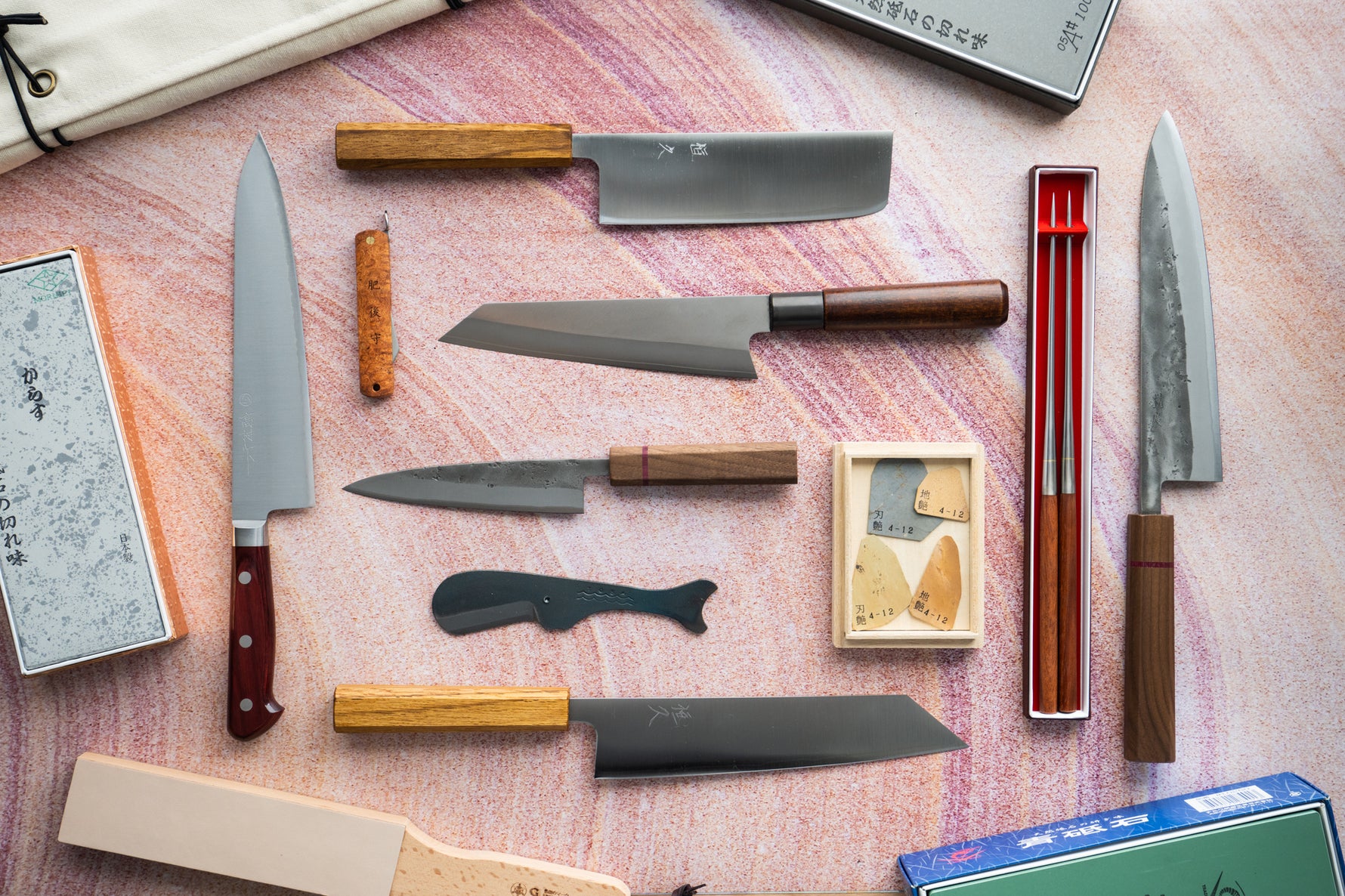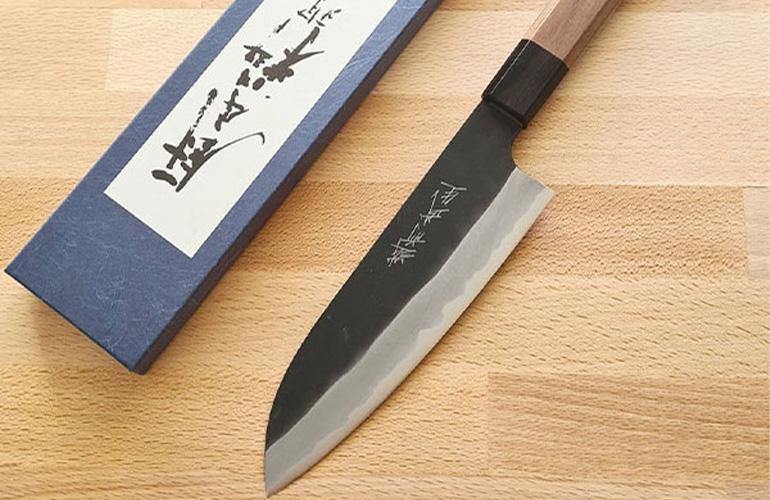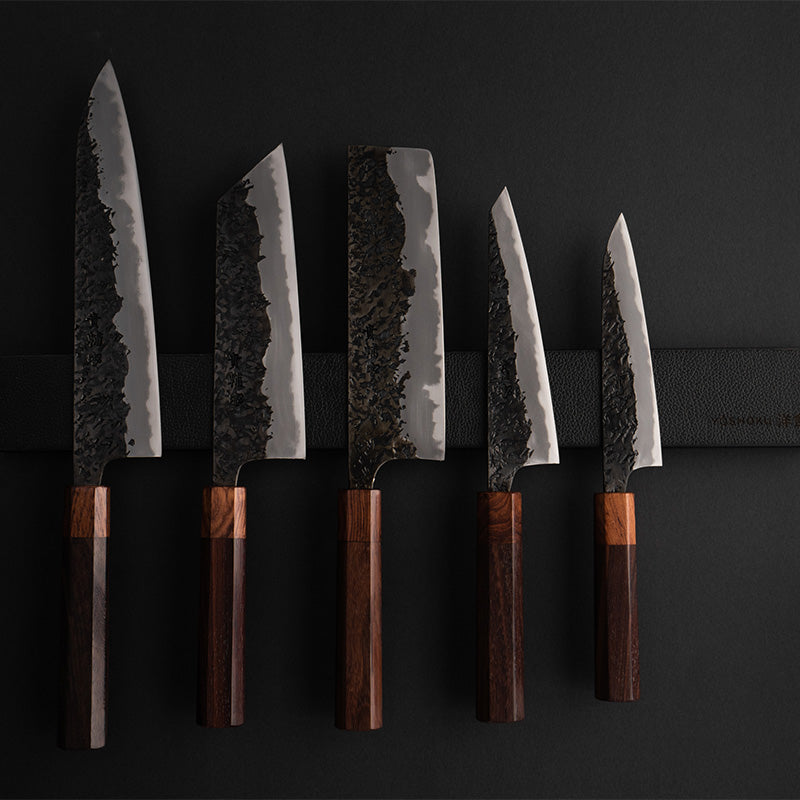Knife Information

Gifting A Japanese Knife - Making the right choice
Which Japanese knife makes the best gift?
Whether it’s a special birthday or an anniversary gift, a fine Japanese knife is a cut above and will be sure to impress. For that person in your life who is an aspiring foodie, loves cooking or would like to take their skills to the next level, a Japanese knife makes an excellent gift for the person who has everything. With everyone spending more time at home, it’s time to take those cooking talents to the next level, and with our range of knives available in Australia, it’s never been easier to find the perfect gift. If you’re new to Japanese knives, a few easy questions can help you decide the perfect gift. The best way to consider what knife suits best is to think about how the lucky recipient will be using it.
For the barbeque lover - Sujihiki
Does your partner love to show off their skills with the American roaster or Tomahawk steaks? Do they like to roll out slabs of beef and flash their knife in the air as they prepare for a hungry crowd? Is there a touch of the theatre in the way they wield their blade? Consider the Okeya Ginsun Sujihiki. This beautiful blade is handcrafted by a father and son team in Miki City Hyogo and features a long blade made with Ginsan, a high carbon stainless steel. With all the benefits of a Carbon Steel without the extra maintenance or worry about rust. The understated elegance of the handle is enhanced by the fine Kanji etched on the blade. It’s a serious blade and it’s seriously lovely to look at.
For the everyday go-to knife – Santoku
For someone that loves to cook but mainly sticks to smaller meat and veg, the Santoku is the perfect introduction to Japanese knives. Try the Tadafusa Seido Santoku. Based on a carbon steel cutting edge but clad in stainless up the side of the blade, it’s easier to maintain than some other carbon steel knives due to the stainless cladding. In a sleek black box, this Octagon handled piece with a Nashiji or “Pear Skin” style finish is a looker and sure to impress.
For the fisherman – Deba
The fish markets are their happy place – they love to wander comparing the different offerings and choosing just the right cuts to create their masterpieces. Whether they’re trying to impress you or a whole crowd of friends, they like to delight with their skills and mastery. The best option here is the Deba knife – perfect for fish filleting. With a single edged blade, it is a specialty knife for filleting and removing the heads from fish, rather than general purpose cutting. Try the Ishikawa Blue 2 Deba 180 MM. The maker of this knife puts his emphasis on performance, not appearance, but you wouldn’t know this from looking at this spectacular understated blade. Sometimes a whisper says more than a shout.
For the allrounder – Bunka
They watch MasterChef and Iron Chef and call out the contestants for bad technique. They are most happy taking on food challenges in their own home. They believe you should only have one kitchen knife…and that knife should be an amazing allrounder. Buy them the Kanjo HAP40 Bunka and watch them clap their hands with glee at the stunning polished blade with dimple hammer-marks from the blacksmith, and a lightweight, waterproof handle made from timber and resin.
For the faster vegetable chopper in the house – Nakiri
Just because you’re chopping vegetables or whipping up a vegan feast doesn’t mean you can’t have superior performance and a blade to match. They love to show off their knife skills with a “who me? I’m just here cutting up veggies” flourish, as they whirl the whole produce section of their cutting board into a wok. One great suggestion is the Shiro Kamo Shirogami 2 Damascus Nakiri. This is a pure carbon steel knife, and is recommended for those that love their chef knives and don’t mind the extra maintenance. Shirogami is a pure carbon steel with no stainless elements, so be sure to keep that blade dry immediately after use and watch that beautiful blue and purple patina develop on the blade. Featuring the stylish octagonal blade in sexy black walnut, and a delightfully thin grind, the aspiring chef will enjoy slicing and dicing like they’re demonstrating on a cooking show. Why should the meat-eaters be the only ones to get the great knives?
Buy your loved one a Japanese knife today
So there you have it, some great ideas for a special someone who richly deserves it. The best part of giving a knife is that each of these Japanese knives has a rich history and culture that goes with them and will become heirlooms over time. They are truly a gift that will get a lot of use and will stand the test of time. Of course, you don’t have to give them away – you could always find one for yourself on this list. Order today from Chefs Edge.

Whether you’re a home cook, amateur chef or a professional, we all need a good set of knives in the kitchen.
For many chefs it’s what defines them, and a Japanese chef knife arguably is as good as it gets. Working with the right blade will ensure superior precision and maintain the integrity of the ingredients you’re working with.
Japanese chef knives are becoming increasingly popular with Western chefs, and it’s not surprising given their rich history and reputation for quality, sharpness and overall precision craftsmanship.
At Chefs Edge we specialise in high performance Japanese kitchen knives crafted by some of Japan’s most talented blacksmiths. We only pursue kitchen knives of the highest quality and the finest craftsmanship, and provide them to you at the best possible price, while striving to deliver the best customer service possible.
If you’re considering Japanese chef knives for your kitchen, it’s important to first understand the different kinds, to help you decide what’s right for you. The types of kitchen knives you need will ultimately depend on your level and style of cooking, and the techniques you’ll demand from your knife.
Gyuto
If you’ve never owned a Japanese kitchen knife before, the Gyuto meaning ‘beef knife’ is the most versatile choice to start your collection and obsession! One of the most commonly used knives in the kitchen, the Gyuto can cover a majority of kitchen tasks.
It’s similar to a classic Western style chef’s knife, except that it’s typically lighter and thinner. The Gytuo is typically anywhere between 18cm-27cm in length, depending on the required task. It has a long curve from heel to point and is ideal for rocking-cuts and precision work like mincing, fine preparation of vegetables and slicing meat.
Shop our range of Gyuto’s here
Santoku
If you’re looking for another good all-rounder, a Santoku knife is your next best choice after the Gyuto. This smaller multipurpose knife has a flatter blade profile that the Gyuto, and is great for dicing and chopping vegetables, fish and meat.
The broader blade also helps to scoop ingredients off the board with ease. The Santoku can range from 13cm to 18cm in length, and has a slightly flatter cutting edge than the Gyuto.
Shop our range of Santoku’s here
Bunka
A versatile blend of the Santoku, Gyuto, and Nakiri, the Bunka is a smaller and thinner than the Gyuto and Santoku, with a much higher taller blade, and a ‘K-tip’ which allows more specialised cutting tasks.
This general purpose knife is also ideal for push cutting and chopping vegetables, and can handle delicate work like trimming and paring with ease. (Plus, they look absolutely fantastic, our favourite blade shape by far!)
Shop our range of Bunka’s here
Deba
For Western Chef’s the Deba is the ultimate butcher’s knife alongside the trusty meat cleaver. Although the Deba is traditionally known for its uses in filleting fish, its structure merits its use for cutting through joints of meat and poultry.
You’ll notice that an authentic Japanese Deba will have a single bevel edge, while the Western version has a double bevel edge, which is why it’s also ideal in meat preparation.
The Deba has a thick spine, and is usually heavier than it’s Gyuto/Santoku counterparts. This extra weight helps make light work of more heavy duty cutting tasks.
Nakiri
As its meaning suggests, the Nakiri knife is a vegetable knife. Crafted with a straight double edged blade and no tip, it’s perfect for chopping and dicing.
You’ll find this knife to be everyone’s ‘go to’ in most Japanese homes. The flatter blade profile allows more of the cutting edge to be in contact with the board.
Shop our range of Nakiri’s here
Petty
The Japanese version of a French petit knife, the Petty knife is the quintessential paring and utility knife.
It’s nimble and perfect for small handheld tasks that the Gyuto or Santoku is too large for, such as peeling and cutting small fruit, vegetables and herbs. The small length of the blade makes sharpening a breeze compared to other types of knives.
Shop our range of Petty’s here
Yanagiba
The original sushi knife! Traditionally used to cut sashimi, but these days can also be used to cut meat. This is a long, thin blade up to ~37cm in length, and is a single bevel, chisel ground edge. This ensures the meat falls off to one side and repeated cuts can be made to large pieces of meat in quick succession with excellent repeatability.
Other types of Japanese kitchen knives
Chukabocho – the Japanese version of a cleaver, it is large and rectangular in shape and great for preparing large veggies such as cabbage. The thin blade also means it can handle delicate tasks like trimming and mincing herbs. This cleaver is not designed to be used as a meat cleaver.
Pankiri – a serrated bread knife, only used for slicing bread and baked goods.
Usuba – a vegetable knife with a Kataba blade. This knife is a little more difficult to use than a Nakiri, but its shape and sharpness ensures a clean and crisp cut every time.
Whether it’s slicing and dicing, chopping or carving, you’ll find the perfect workhorse in the kitchen with a Japanese kitchen knife. If you need help deciding on what knife will best suit your needs, get in touch with the team at Chefs Edge. Once you’ve got your hands on a Japanese kitchen knife you’ll never look back!

A Guide to Japanese Knives (2021)
A Guide to Japanese Knives
In the culinary world, Japanese knives are highly praised. We're here to tell you that they truly live up to the hype. Japanese knives are the product of a rich culture. Skilled artisans use the finest materials and techniques to make these high-quality tools. Many varieties are available that serve different purposes in the kitchen.
Looking to add Japanese knives to your arsenal? We don't blame you. These tools make a great addition to your kitchen. They also go a long way in helping you prepare authentic cuisine.
Not sure how to find the right Japanese knife in Australia? You're not alone. It can be tricky when you're not familiar with these traditional tools. Luckily, we're here to help!
Here's a complete guide to Japanese knives. We'll go over different materials, varieties, and more to help you become an informed buyer.
Western vs. Japanese Knives
Before diving in, it's worth mentioning the main differences between Western and Japanese knives.
Material Quality
Western knives are easier to care for. They aren't as brittle and won't rust as easily. Their Japanese counterparts require more care as they are more brittle and prone to rust. However, they tend to be sharper and hold their edge longer.
Blade Shape
Traditional Japanese knives have a single-bevelled blade, where one side is sharpened, and the other side is completely flat. A chef uses this blade to make precise diagonal cuts. Note that because just one side of the blade is sharpened, a single-bevelled knife is made for right-handed chefs. If you are left-handed, you will have to get a specialty leftie knife (which can be more expensive).
Western knives, on the other hand, usually have double-bevelled blades. They are sharpened on both sides, resulting in a V-shaped blade edge. Though easier to sharpen, this blade isn't as good for high-precision cuts. But, you'll be glad to hear that double-bevelled blades are ambidextrous by design. Both left- and right-handed chefs can use them with ease.
Know the Different Materials
Now, let's take a look at the different materials Japanese knives are made out of.
Carbon Steel
Relatively speaking, carbon steel is sharper and less resistant to wear. When it does become dull, it's easier to sharpen.
Carbon steel is also more brittle and prone to rust. Professional chefs are more likely to own carbon steel knives to keep up with the required maintenance.
Stainless Steel
Compared to carbon steel, stainless steel isn't as sharp. As a result, it is prone to wear and slightly more difficult to sharpen.
Stainless steel, however, has many perks. It is easier to care for as it isn't as brittle or prone to rust. This makes it a popular choice among amateur chefs.
Different grades of stainless steel knives (VG-10, 10A, or AUS-10, etc.) offer unique hardness and edge retention levels.
Damascus Steel
Traditional Damascus steel is no longer made. Modern manufacturers, however, attempt to replicate the historical material.
Damascus steel knives can be made out of either carbon or stainless steel. Their key feature is their beautiful water-like patterns. Many chefs prefer knives made out of this material for aesthetic reasons.
If you are buying a Japanese knife in Australia, consider whether you want a carbon or stainless steel knife. Then, decide if you want a standard design or a beautiful Damascus pattern.
Find the Right Japanese Knife in Australia
The type of material you choose is important. However, you'll also want to find a knife of the right size and shape for what you'll be using it for.
Here are some of the most popular types of Japanese knives:
Gyuto
A Gyuto is not necessarily a traditional Japanese knife. It is a Japanese adaptation of the Western chef's knife.
A Gyuto has a curved blade, tall heel, and pointed tip. Its blade is usually around 210-270mm in length. While chefs use it for various applications, a Gyuto is particularly useful for piercing and rocking motions.
Garasuki
A Garasuki is another Japanese adaptation. It mimics a Western boning knife.
The triangular blade is tough and has a sharp tip. While not good for cutting through bones, it is great for maneuvering around tight spaces. Chefs often use it to break down poultry and red meat.
Honesuki
A Honesuki is essentially a smaller version of a Garasuki.
Santoku
A Santoku (along with the rest of the knives we'll be discussing) is a traditional Japanese knife.
A Santoku is similar to a Gyuto in that it is all-purpose. The name, translating to “three virtues,” refers to its ability to cut meat, fish, and vegetables. With a Santoku, chefs tend to use an up-and-down motion rather than a rocking motion.
Nakiri
A Nakiri is for cutting, slicing, and peeling vegetables. The double-bevelled blade, which can be between 240-300mm, is thin and straight.
Usuba
An Usuba is the single-bevelled version of a Nakiri. Its blade is much thinner, making it perfect for decorative cuts and paper-thin slices.
Takohiki
Chefs use a Takohiki to slice raw fish for sashimi. The blade is rectangular.
Yanagiba
A Yanagiba is also used to slice raw fish for sashimi. The blade, however, is slim, long, and has a curved tip.
Deba
A Deba is for breaking down fish. The chunky blade can cut through bones, descale, etc. A standard size Deba (Hondeba) has a blade length of 210mm.
Unagisaki
A Unagisaki is for preparing Unagi. The sharp tip can pierce through the slippery eel's skin and filet the fish.
Menkiri
Chefs use a Menkiri to cut through soba noodles and udon. A Menkiri is heavy, has a straight edge, and features a blade that extends to the handle.
Buy Your Japanese Knife in Australia
With the help of this guide, you should find the perfect Japanese knife in Australia. Just keep in mind that these knives are crafted with care, and you'll need to keep them in pristine condition if you want to get your money's worth.
